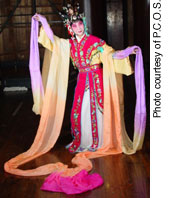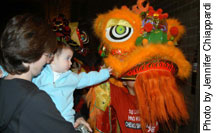
|
The Year of The Dog:
|
 |
The Philadelphia Chinese Opera Society performs The Banner Dance from ‘The Flower Fairy’ and other selections at Penn Museum’s 25th Annual Chinese New Year Celebration. |
Bark for joy! The University of Pennsylvania Museum of Archaeology and Anthropology ushers in the Year of the Dog Saturday, January 21, 2006, 11 a.m. to 4 p.m., with its 25th annual Chinese New Year Celebration! Music and dance performances, food, healing and martial arts demonstrations, games, workshops, arts, crafts, children’s activities and much more—topped off with the traditional Chinese Lion Dance grand finale—are all part of the spectacular day-long celebration, free with Museum admission donation ($8 general admission; $5 students and seniors; free for children under 6, Museum members and PennCard holders).
Live music, dance and special performances bring the sights, sounds and spectacles of China to Museum galleries and auditoriums. New this year, the Philadelphia Chinese Opera Society presents “Change of Faces,” a mystifying quick-change act; “The Banner Dance from ‘The Flower Fairy,’” a challenging dance that incorporates martial arts; and the martial action comedy “The Monkey King,” from 11 to 11:30 a.m. in the Harrison Auditorium. The Society conveys Chinese historical and literary tales through the 200-year-old Beijing Opera art form, including interpretive dance and traditional costumes.
Musicians Kurt Jung and Anna Chan offer two presentations on the differences between Eastern and Western musical instruments, comparing the erhu to the violin, the gu-zheng (Chinese zither) to the harp, and the ruan to the Western-style guitar from 11:30 a.m. to noon, and from 2 to 2:45 p.m.
The Mei-Mei Dancers (ages 3 to 8) perform traditional dances from noon to 12:30 p.m. in the Harrison Auditorium, and the University of Pennsylvania’s Pan-Asian Dance Troupe offers a program from 1 to 1:30 p.m. that blends traditional dances with modern styles and music such as funk and hip-hop.
Chinese healing and martial arts continue to gain popularity in America, and this celebration offers visitors the opportunity to see and learn more about several traditions. Dr. Ching-Yao Shi offers a lecture on insomnia treatments using acupuncture and Chinese medicinal herbs, at 11:30 a.m. in the Rainey Auditorium.
Onlei Annie Jung, a Chinese brush painting and calligraphy instructor at the Perkins Center for the Arts, joins the festivities this year to teach visitors some basic brush strokes for painting and writing Chinese characters at workshops held in Classroom 2 from 11 a.m. to 1 p.m. and again from 2:30 p.m. to 3:45 p.m.
Visitors can stop by the Lower Egyptian Gallery from 12:15 to 12:45 p.m. to see Falun Gong practitioners demonstrate this widely-practiced system of healing exercises based on the art of QiGong and the principles of truth, compassion, and tolerance. Master John Chen from Ba’Z Tai Chi & Kung Fu Studio offers a Tai Chi demonstration from 1 to 1:40 p.m. At 3 p.m. in the Harrison Auditorium, members of Cheung’s Hung Gar Kung Fu Academy offer a Kung Fu demonstration.
Activities for children and families abound. Chinese New Year traditions, such as the Chinese zodiac and its legend, how the New Year is celebrated in China, and the customary decorations, are the subjects of a workshop run by Ting Ting Jin, bilingual counseling assistant at the McCall School, in the second floor Nevil classroom, 11 a.m. to 3 p.m. Artist Yu-Yang leads a children’s craft workshop centered around the Year of the Dog in the Chinese Rotunda from 1:30 to 4 p.m.
The Penn Museum features a world-famous collection of early monumental Chinese art, on display in the majestic Chinese Rotunda. A 19th century crystal ball believed to have been owned by the Dowager Empress serves as the gallery’s centerpiece. Students from Penn’s Chinese Student Association offer information tables about Chinese culture, and demonstrate and teach popular Chinese games such as ‘Mahjong’ and ‘Go’ in the Rotunda throughout the day.
The Rotunda is also the site for demonstrations by area artists, including paper cutting by Fan-ling Chen and Chinese calligraphy by Bi Rui-lan. The Museum’s three shops–the Museum Shop, Second Site, and the Pyramid Shop for Children–spotlight their colorful selection of Chinese arts, crafts, games and books for the event. Artist Chen Lok Lee demonstrates Chinese painting in the nearby Upper Egyptian Gallery from 11 a.m. to 2 p.m.
The Jade River Dancers perform in the Harrison Auditorium from 2 to 2:40 p.m., drawing from their repertoire of traditional dances including the Hat Dance, Iron Fan Dance, and the Spinning Handkerchief Dance. Boys with the troupe demonstrate their dexterity with the giant Chinese yo-yo. Young dancers from the Plum Flower Dance Company perform in the Lower Egyptian Gallery from 3:15 to 3:45 p.m.
Chinese food—decorative and edible—is always a featured part of the festivities. Chef Joe Poon returns to the Museum to give his ever-popular afternoon vegetable carving demonstration from 2 to 4 p.m. in the Upper Egyptian Gallery, when he quickly and skillfully turns modest vegetables into flowers, birds, and fanciful scenes. In addition, the Museum Cafe features several Chinese lunch entrees.
 |
Cheung’s Hung Gar Kung Fu Academy presents the ever-popular finale to Penn Museum’s 25th Annual Chinese New Year Celebration on Saturday, January 21. |
No Chinese New Year Celebration is quite complete without the traditional Lion Dance to chase away evil and usher in a year of good luck. After their Kung Fu demonstration from 3 to 3:45 p.m. in the Harrison Auditorium, lion dancers and drummers from Cheung’s Hung Gar Kung Fu Academy wind their way outside, weather permitting, to the Upper Courtyard Garden for a boisterous finale.
Chinese New Year Celebration 2006 Schedule
11-11:30 a.m.–Philadelphia Chinese Opera Society Performance, Harrison Auditorium
11 a.m.-1 p.m.–Calligraphy and Brush Painting Workshop, Classroom 2
11 a.m.-2 p.m.–Chinese Painting Demonstrations, Upper Egypt
11 a.m.-3 p.m.–Chinese New Year Traditions Workshop, Nevil Classroom
11:30 a.m.-noon–Eastern vs. Western Musical Instruments, Lower Egypt
11:30 a.m.-12:30 p.m.–Acupuncture, Herbal Medicine, and Insomnia, Rainey Auditorium
noon-12:30 p.m.–Mei-Mei Dancers Performance, Harrison Auditorium
12:15-12:45 p.m.–Falun Gong Demonstration, Lower Egypt
1-1:30 p.m.–Penn’s Pan-Asian Dance Troupe Performance, Harrison Auditorium
1-1:40 p.m.–Tai Chi Demonstration, Lower Egypt
1:30-4 p.m.–Children’s Craft Workshop, Chinese Rotunda
2-2:40 p.m.–Jade River Dance Company Performance, Harrison Auditorium
2-2:45 p.m.–Eastern vs. Western Musical Instruments (Children), Lower Egypt
2-4 p.m.–Joe Poon Vegetable Carving Demonstration, Upper Egypt
2:30-3:45 p.m.–Calligraphy and Brush Painting Workshop, Classroom 2
3-3:45 p.m.–Cheung’s Hung Gar Kung Fu Demonstration, Harrison Auditorium
3:15-3:45 p.m.–Plum Flower Dance Company Performance, Lower Egypt
3:45-4–Lion Dance and Parade, Harrison Auditorium